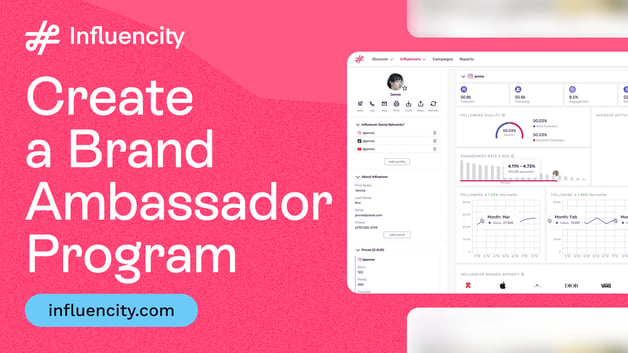What to Consider When Creating an E-Commerce Marketing Plan
An effective e-commerce marketing plan is an essential cornerstone of a successful online business. It serves as a strategic roadmap that navigates the intricate landscape of digital commerce, outlining a series of actionable steps and tactics designed to promote, engage, and convert online consumers.
But what should you include in your e-commerce marketing plan? Which elements are crucial for steering your online business towards success?
In today’s article, we will explain what an e-commerce marketing plan is and outline crucial considerations that you need to keep in mind when you design your own strategy. Specifically, we will discuss the importance of considering your target audience, budget, and promotional channels, and how to seamlessly integrate influencer marketing into your plan.
What is an E-commerce Marketing Plan?
An e-commerce marketing plan is a strategic blueprint outlining the tactics and strategies a business intends to use to promote and sell its products or services online. The aim is to establish a clear marketing roadmap that aligns with a business's goals and target audience, ultimately driving traffic, engaging customers, and boosting online sales.
An e-commerce marketing plan typically includes details on target audiences, competitive analysis, pricing strategies, branding efforts, content creation, social media engagement, search engine optimization (SEO), pay-per-click advertising, email marketing, and more. The primary goal is to enhance an e-commerce brand’s online presence, attract potential consumers, and ultimately convert them into loyal customers.
Crucial Considerations for Crafting an Effective E-commerce Marketing Plan
Crafting an effective e-commerce marketing plan involves considering several crucial elements in order to maximize reach, engagement, and conversions. The plan also needs to be dynamic and adaptable, evolving with changes in market trends to ensure effective online visibility, customer engagement, and revenue generation.
With this in mind, we are now going to explore everything you need to keep in mind when you design your e-commerce marketing plan. By considering the following aspects, you'll be better equipped to attract and connect with your target audience, drive meaningful engagement, and boost brand visibility and sales.
Target Audience
Your target audience is the specific group of individuals who are most likely to be interested in and benefit from your products or services. These are the people you aim to reach, engage, and ultimately convert into loyal customers. Understanding your target audience is essential for crafting an effective eCommerce marketing plan that resonates with the needs, preferences, and behaviors of your target consumers.
To define your target audience, consider factors such as demographics (age, gender, location), psychographics (values, interests, lifestyle), buying behavior (online habits, purchasing frequency), and pain points (challenges consumers face that your product can solve).
Building detailed buyer personas based on all this information can help you visualize and empathize with your audience, leading to more targeted and impactful marketing efforts. Plus, by pinpointing and catering to your target audience's preferences and motivations in this way, you can create a more personalized and relevant experience. This approach not only increases the likelihood of attracting the attention of potential customers but also fosters a stronger connection that translates into higher engagement and improved conversion rates.
Budget Allocation
Another key aspect that you need to consider in depth when you design your e-commerce marketing plan is your budget. You need to make sure that your budget allocation aligns strategically with your business goals and the scope of your marketing initiatives. That way, you will avoid overspending while ensuring you have the necessary resources to execute your strategies effectively.
Begin by setting a realistic and comprehensive budget that takes into account various expenses such as advertising costs, content creation, platform fees, and potential unexpected expenses. Prioritize channels that have shown consistent performance and bring a higher return on investment (ROI), allocating a larger portion of your budget to these proven avenues.
It’s also important to reserve a portion of your budget for experimenting with new, innovative strategies that could yield promising results. The 70-20-10 rule is a good framework for this. This is where you dedicate 70% of your budget to proven strategies, 20% to emerging tactics, and 10% to experimental strategies.
Finally, remember that flexibility is key. As market trends and consumer behaviors change, be prepared to reallocate your budget to adapt to these shifts.
Promotional Channels
The next stage in designing your e-commerce marketing plan is defining which promotional channels you will be focusing on with your marketing efforts. This is important because the channels you choose are likely to significantly impact your reach, engagement, and conversion rates.
Your promotional channels might include:
- Search Engine Optimization (SEO): Optimizing website content to rank higher on search engine results, driving organic traffic.
- Pay-Per-Click (PPC) advertising: Investing in targeted ads on platforms like Google Ads or social media, with costs based on clicks or impressions.
- Social media marketing: Engaging potential customers on platforms tailored to their preferences, using both organic content and paid advertising.
- Email marketing: Nurturing leads and maintaining customer relationships through personalized email campaigns.
- Content marketing: Crafting valuable and informative content, such as blog posts, videos, and infographics, to attract and engage audiences.
- Affiliate marketing: Partnering with affiliates and influencers to broaden your reach and leverage their networks.
Influencer Marketing
Finally, one of the most effective strategies for enhancing the power of your e-commerce marketing plan involves collaborating with influential figures in your industry or niche to tap into their engaged audience, enhance brand credibility, and reach a wider demographic. In other words, integrating influencer marketing in your e–commerce marketing plan. In fact, working with the right influencer can be instrumental in fostering authenticity, credibility, and connection with your target customer base.
Here are the basics that you need to keep in mind:
- Identify relevant influencers: Choose individuals whose audience aligns with your target demographic and brand values.
- Set clear objectives: Define goals, whether it's boosting brand awareness, driving sales, or increasing website traffic.
- Establish authentic partnerships: Cultivate relationships with influencers who genuinely appreciate your products, enhancing the credibility of endorsements.
- Negotiate terms and expectations: Create a structured plan outlining the scope of the collaboration, content expectations, timeline, compensation, and metrics for success.
- Diversify content: Allow influencers creative freedom while ensuring their content aligns with your brand's essence.
- Influencer seeding: Consider sending your products to influencers, allowing them to experience and showcase them to their followers organically, building genuine excitement and interest.
Track and measure: Use trackable links, unique referral codes, and engagement metrics to measure the impact of your influencer campaigns and ensure you are reaching the objectives established in your e-commerce marketing plan.
Tags:






















%20and%20How%20Can%20They%20Benefit%20Your%20Brand%20article.jpg?length=628&name=What%20Are%20Key%20Opinion%20Leaders%20(KOL)%20and%20How%20Can%20They%20Benefit%20Your%20Brand%20article.jpg)








